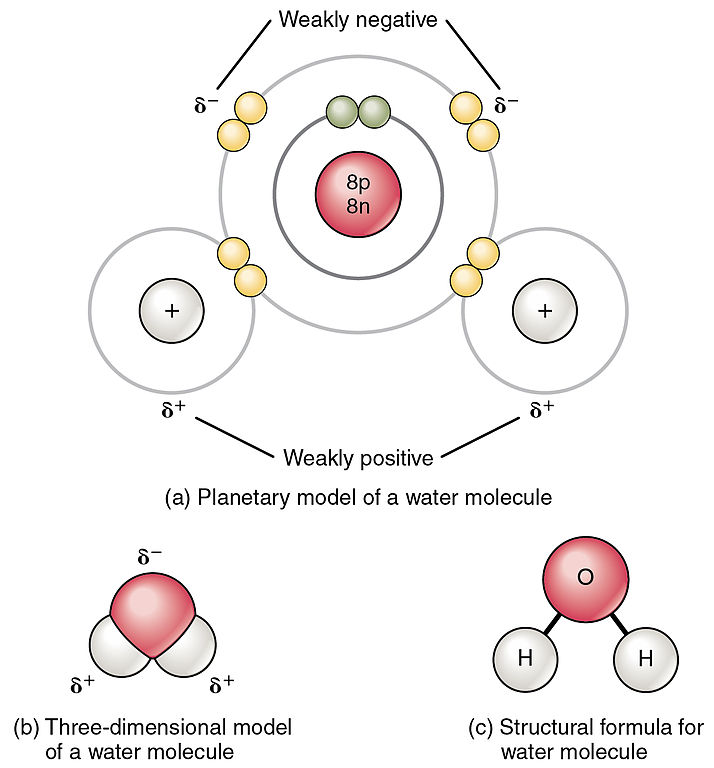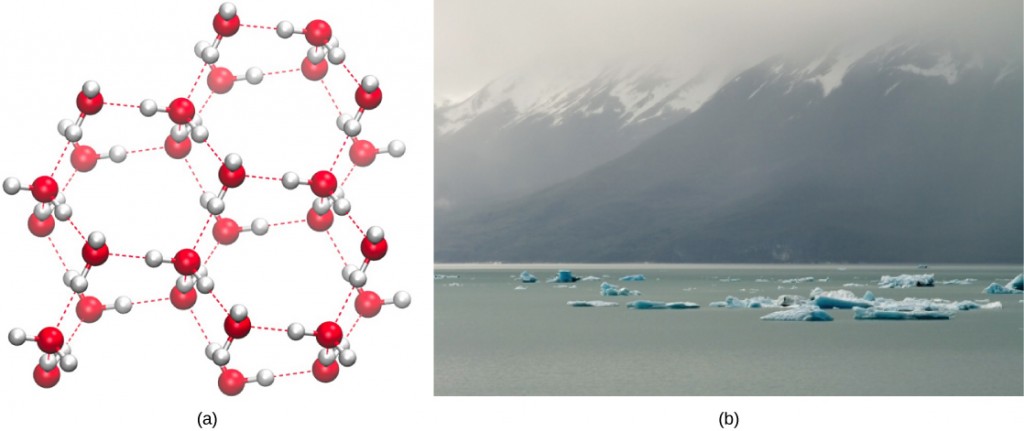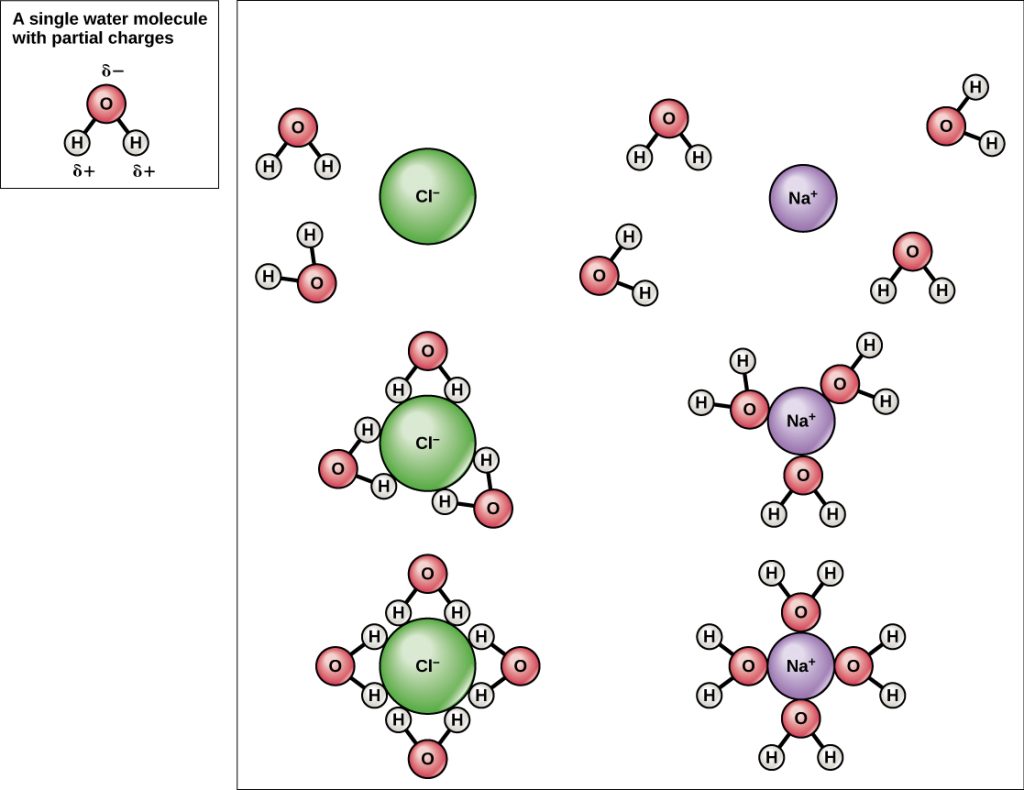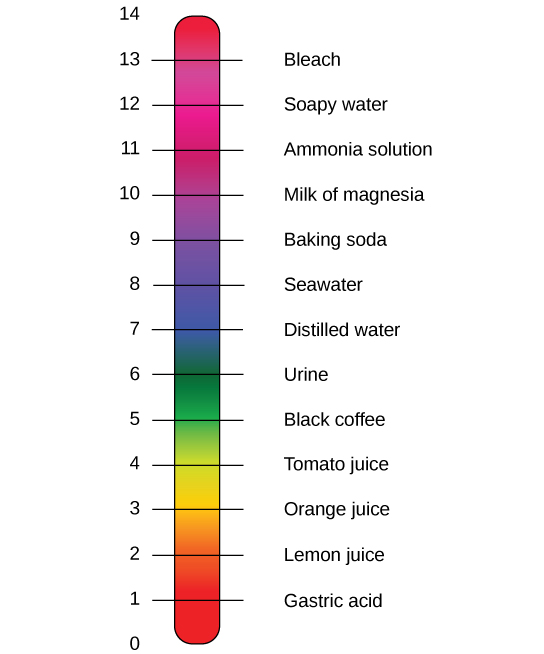2.3 Water
Do you ever wonder why scientists spend time looking for water on other planets? Water is essential to life; even minute traces of it on another planet can indicate that life could or did exist on that planet. Water is one of the more abundant molecules in living cells and the one most critical to life as we know it. Approximately 60 to 70 percent of your body is made up of water. Without it, life would not exist.
Structure of Water
The hydrogen and oxygen atoms within water molecules form polar covalent bonds. The shared electrons spend more time associated with the oxygen atom than the hydrogen atoms. There is no overall charge to a water molecule, but there is a slight positive charge (δ+) on each hydrogen atom and a slight negative charge (δ-) on the oxygen atom. In a solution of pure water, the partial negative charge on the oxygen is attracted to the partial positive charges on other water molecules, forming hydrogen bonds between water molecules. The hydrogen bonds between water molecules are responsible for all the properties of water.

Properties of Water
The properties of water include:
Water is Cohesive

Cohesion is the tendency for molecules of the same kind to be attracted to one another. Cohesion allows water molecules to “stick together” via hydrogen bonding. Have you ever filled a glass of water to the top and slowly added a few more drops? Before it overflows, the water forms a dome-like shape above the rim of the glass because of cohesion.
Cohesion gives rise to surface tension, the capacity of a substance to withstand rupture when placed under tension or stress. When you drop a small scrap of paper onto a droplet of water, the paper floats on top of the water droplet, although the object is denser (heavier) than the water. This occurs because of the surface tension created by the water molecules. Cohesion and surface tension keep the water molecules intact and the item floating on top. If you place it gently without breaking the surface tension, it is possible to “float” a steel needle on top of a glass of water.
These cohesive forces are also related to the water’s adhesion property or the attraction between water molecules and other molecules. This is observed when water “climbs” up a straw placed in a glass of water. You will notice that the water appears higher on the sides of the straw than in the middle. This is because the water molecules are attracted to the straw and adhere to it.
Cohesive and adhesive forces are essential for sustaining life. In the human body, cohesion of water molecules ensures that when water moves in and out of capillaries, one water molecule will be followed by many water molecules. This bulk movement of water ensures fluid balance within the body. The cohesion of water also allows water to flow from the roots up to the leaves to feed the plants.
Water Stabilizes Temperature
The hydrogen bonds in water allow it to absorb and release heat energy more slowly than many other substances. Temperature is a measure of the motion (kinetic energy) of molecules. As motion increases, energy and temperature increase. Water absorbs a great deal of energy before its temperature rises. Energy must be invested to break the hydrogen bonds that hold water molecules together before those water molecules can move freely. Once the hydrogen bonds have been broken, individual water molecules move faster (gain kinetic energy), resulting in a change in temperature.
The release of individual water molecules at the surface of the liquid (such as a body of water, the leaves of a plant, or the skin of an organism) is called evaporation. Evaporation of sweat, which is 90 percent water, allows for the cooling of an organism because breaking hydrogen bonds requires an input of energy and takes heat away from the body.
Conversely, water also takes a long time to cool. Once you have brewed your tea, you must wait for the tea to reach a drinkable temperature. As water cools, the molecules slow their movement and energy is released as the hydrogen bonds between water molecules re-form. That energy keeps the temperature of the water relatively constant, even though you have stopped heating the water.
The ability for water to stabilize temperature makes Earth habitable. Heat from the atmosphere is absorbed by water in oceans, ensuring that the temperature on Earth’s surface does not exceed a livable temperature. Water can release heat to cool atmospheric air, again, keeping the temperature on Earth’s surface relatively constant. Life on Earth is possible because of the ability of water molecules to form hydrogen bonds!
Water Expands Upon Freezing
For most substances, the solid state of matter is denser than the liquid state of the same substance. As atoms and molecules slow their movement at low temperature, they get closer together. Generally, this increases the density of a substance. Density is a measure of how much mass is contained in a given volume. It indicates how tightly matter is packed together.
Water is one exception to this rule. Ice is less dense (the molecules are farther apart) when frozen compared to liquid water. In liquid water, some molecules are bound together by hydrogen bonds, but some molecules move freely. As liquid water freezes and hydrogen bonds form between water molecules, it creates a rigid, lattice-like structure (e.g., ice) (Figure 2.3.3 a). The fixed geometry of the lattice prevents water molecules from packing close together and, therefore, from becoming denser as it freezes. Instead, water expands upon freezing.
This means that ice floats on the surface of a body of water (Figure 2.3.3 b). Ice will form on the water’s surface in lakes, ponds, and oceans, creating an insulating barrier to protect the animal and plant life beneath from freezing in the water. If this did not happen, plants and animals living in water would freeze in a block of ice and could not move freely, making life in cold temperatures difficult or impossible.

Water is a Versatile Solvent
Water is the solvent for most of life’s chemical reactions. A solution is a uniform mixture of a liquid and substances dissolved in that liquid. A solution consists of a solvent (a substance capable of dissolving another substance) and a solute (a substance dissolved in the solvent).
Because water is polar, with slightly positive and negative charges, ionic compounds (such as salt) and polar molecules (such as sugar) can readily dissolve. The charged particles will form hydrogen bonds with a surrounding layer of water molecules. This is a sphere of hydration that keeps the particles separated or dispersed in the water. In the case of table salt (NaCl) mixed in water, the sodium and chloride ions separate, or dissociate, in the water, and spheres of hydration are formed around the ions. A positively charged sodium ion is surrounded by the partially negative charges of oxygen atoms in water molecules. A negatively charged chloride ion is surrounded by the partially positive charges of hydrogen atoms in water molecules. These spheres of hydration are also referred to as hydration shells. The water molecule’s polarity makes it an effective solvent and is essential in its many roles in living systems.
When a substance readily forms hydrogen bonds with water, it can dissolve in water and is called hydrophilic (“water-loving”). Hydrogen bonds are not readily formed with nonpolar substances like oils and fats. These nonpolar compounds are hydrophobic (“water-fearing”) and will not dissolve in water.

Water can dissolve a wide range of substances, which are crucial to facilitate chemical reactions and the transport of nutrients and waste within organisms. For example, blood, which is mostly water, is essential for transporting nutrients, oxygen, and waste products throughout the body.
Exercise 2.3.1
Text Description
- Water is _____ because the oxygen atom is partially negatively charged, and the hydrogen atoms are partially positively charged.
- _____ substances dissolve easily in water, while _____ substances do not.
- Water stabilizes _____ because it can absorb a lot of energy before it changes state (i.e., from liquid to gas).
- Water is an excellent _____ because it can dissolve polar and ionic compounds.
- _____ is caused by hydrogen bonds holding water molecules together. This also causes _____, which allows objects to float on the surface of the water, held up by all the hydrogen bonds.
- _____ is the attraction between water molecules and other molecules.
- hydrophobic
- Cohesion
- polar
- Hydrophilic
- Adhesion
- surface tension
- solvent
- temperature
Answers:
- Water is polar because the oxygen atom is partially negatively charged, and the hydrogen atoms are partially positively charged.
- Hydrophilic substances dissolve easily in water, while hydrophobic substances do not.
- Water stabilizes temperature because it can absorb a lot of energy before it changes state (i.e., from liquid to gas).
- Water is an excellent solvent because it can dissolve polar and ionic compounds.
- Cohesion is caused by hydrogen bonds holding water molecules together. This also causes surface tension, which allows objects to float on the surface of the water, held up by all the hydrogen bonds.
- Adhesion is the attraction between water molecules and other molecules.
Buffers, pH, Acids, and Bases
The pH of a solution is a measure of its acidity or alkalinity. You have probably used litmus paper, treated with a natural water-soluble dye as a pH indicator, to test how much acid or base (alkalinity) exists in a solution. You might have even used some to ensure the water in an outdoor swimming pool is treated correctly. This pH test measures the number of hydrogen ions in a given solution in both cases. High concentrations of hydrogen ions yield a low pH, whereas low levels of hydrogen ions result in a high pH. The overall concentration of hydrogen ions is inversely related to its pH and can be measured on the pH scale (Figure 2.3.5). Therefore, the more hydrogen ions present, the lower the pH; conversely, the fewer hydrogen ions, the higher the pH.
The pH scale ranges from 0 to 14. A change of one unit on the pH scale represents a change in the concentration of hydrogen ions by a factor of 10, and a change in two units represents a change in the concentration of hydrogen ions by a factor of 100. Thus, small changes in pH represent significant changes in the concentrations of hydrogen ions. Pure water is neutral. It is neither acidic nor basic and has a pH of 7.0. Anything below 7.0 (ranging from 0.0 to 6.9) is acidic, and anything above 7.0 (7.1 to 14.0) is alkaline. The blood in your veins is slightly alkaline (pH = 7.4). The environment in your stomach is highly acidic (pH = 1 to 2). Orange juice is mildly acidic (pH = approximately 3.5), whereas baking soda is basic (pH = 9.0).

Figure 2.3.5 Description
- Acidic examples below 7.0 include gastric acid (1), lemon juice (2), orange juice (3), tomato juice (4), black coffee (5), urine (6)
- Neutral example includes distilled water (7)
- Alkaline examples above 7.0 include seawater (8), baking soda (9), Milk of magnesia (10), ammonia solution (11), soapy water (12), bleach (13)
Acids are substances that provide hydrogen ions (H+) and lower pH, whereas bases provide hydroxide ions (OH–) and raise pH. The stronger the acid, the more readily it donates H+. For example, hydrochloric acid and lemon juice are very acidic and readily give up H+ when added to water. Conversely, bases are those substances that readily donate OH–. The OH– ions combine with H+ to produce water, which raises a substance’s pH. Sodium hydroxide and many household cleaners are very alkaline and give up OH– rapidly when placed in water, increasing the pH.
Most cells in our bodies operate within a very narrow window of the pH scale, typically ranging only from 7.2 to 7.6. If the body’s pH is outside of this range, the respiratory system malfunctions, as do other organs. Cells no longer function properly, and proteins break down. Deviation outside of the pH range can induce coma or even cause death.
So, how is it that we can ingest or inhale acidic or basic substances and not die? Buffers are the key. Buffers readily absorb excess H+ or OH–, keeping the body’s pH in the narrow range. Carbon dioxide is part of a prominent buffer system in the human body; it keeps the pH within the proper range. This buffer system involves carbonic acid (H2CO3) and bicarbonate (HCO3–) anion. If too much H+ enters the body, bicarbonate will combine with the H+ to create carbonic acid and limit the decrease in pH. Likewise, if too much OH– is introduced into the system, carbonic acid will rapidly dissociate into bicarbonate and H+ ions. The H+ ions can combine with the OH– ions, limiting the increase in pH. While carbonic acid is an essential product in this reaction, its presence is fleeting because it is released from the body as carbon dioxide gas each time we breathe. Without this buffer system, the pH in our bodies would fluctuate too much, and we would fail to survive.
Exercise 2.3.2
Drag each item to its corresponding substance type.
Text Description
Substances that make up a pH solution: Acid, Base, and Neutral
Draggable items: pH equal to 7, pH greater than 7, pH less than 7, Water, Bleach, Orange juice, Alkaline, Readily donates H+, Readily donates OH-, High concentrations of hydrogen ions, Low concentrations of hydrogen ions
Answers:
- Acid: pH less than 7; Orange juice, High concentrations of hydrogen ions, Readily donates H+
- Base: pH greater than 7; Alkaline, Bleach, Low concentrations of hydrogen ions, Readily donates OH-
- Neutral: pH equal to 7; Water
Text Description
- Are a strong acid or a strong base.
- Help maintain homeostasis.
- Absorb excess H+ or OH-
- Are uncommon in biological systems.
“2.2 Water” from Biology and the Citizen by Colleen Jones is licensed under a Creative Commons Attribution 4.0 International License, except where otherwise noted.
“Water molecules exhibit cohesion” from Chemistry for Biology 1190 Students Copyright © by Julia Wong is licensed under a Creative Commons Attribution-NonCommercial 4.0 International License, except where otherwise noted.

